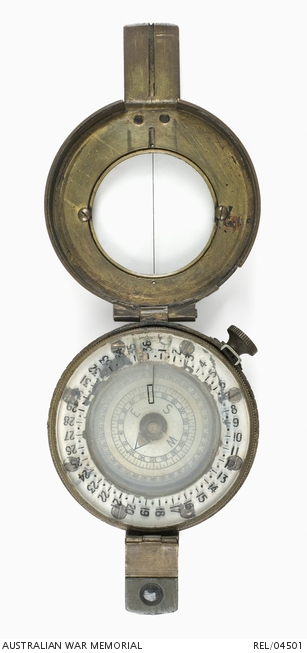| Place | Asia: Netherlands East Indies, Timor Sea |
|---|---|
| Accession Number | REL/04501 |
| Collection type | Technology |
| Object type | Technology |
| Physical description | Brass, Glass |
| Location | Main Bld: Hall of Valour: Main Hall |
| Place made | United Kingdom |
| Date made | 1942 |
| Conflict |
Second World War, 1939-1945 |
Prismatic compass Mk III : HMAS Armidale

Mark III, British prismatic compass. The compass has a hinging lid centrally set with a glass viewing lens with a vertically scribed aiming line in the centre. The height adjustable pivoting brass and prismatic glass viewer folds over the lens allowing the user to see the aiming point and the compass dial simultaneously. The turnable glass and brass lens cover is graduated in single degrees up to three hundred and sixty. Suspended within the compass liquid is the dial, marked 'N', 'S', 'E' & 'W'. This dial is marked in single units plus units of ten degrees around the circumference. There are also units of degrees and direction etched to the outside circumference of the compass. Attached to the one o'clock position of the compass is a dial tensioning mechanism.
This prismatic compass originated from the corvette, HMAS Armidale, which was attacked and sunk by Japanese aircraft, north west of Darwin, on 1 December 1942. HMAS Armidale left Darwin shortly after midnight on 29 November 1942, on board was the 83 crew, 3 AIF Bren gunners and Dutch and Netherlands East Indies soldiers. After the attack, this compass was found on the body of a Dutch Netherlands East Indies soldier. It was used by Lieutenant Lloyd Palmer to navigate Armidale's whaler toward the Australian coast. The compass was carried by Leading Seaman and Chief Bosun's Mate, Leigh Henry Bool, who along with Palmer and others, was rescued on 9 December 1942. After the war, the compass was kept by Leading Seaman Bool.